By David and Susan Greenberg
We heard:
1/ An avalanche of empty wine bottles from each night’s revelry poured from dumpsters into trucks for removal at 4 AM, like the sound of dozens of chandeliers crashing onto a concrete floor.
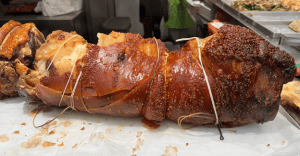
2/ The sound of crackling pork skin on porchetta sandwiches (preferably on fresh focaccia) as we bit in,
3/ The sort of doppler-effect sirens you hear in Jason Bourne movies when he’s being chased,
4/ Wheeled luggage pulled along cobblestones,
5/ Huffing and puffing to the tops of cathedrals,
6/ Church bells.
We smelled:
1/ Truffles
2/ Fresh-squeezed blood orange juice,
3/ Roasting chestnuts,
4/ Parmesan cheese,
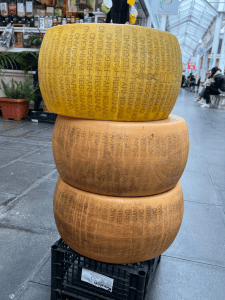
5/ Salamis,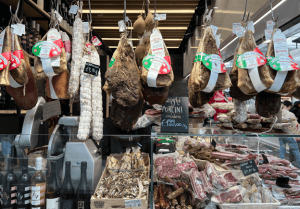
6/ Sidewalks after rain.
We saw:
1/ Fountains, fountains, fountains, most with huge marble statues of Roman gods tussling, blowing horns, riding horses, scallywagging and horndogging. The gods were a randy lot with poor impulse control.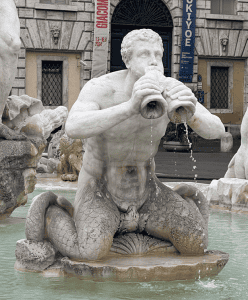
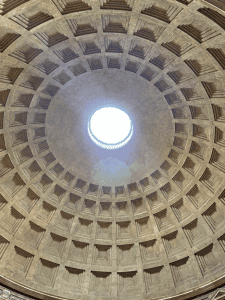 2/ The Pantheon, a Roman temple converted to a Christian temple with the largest unsupported concrete dome in the world. Built two thousand years ago, it would test the limits of today’s engineering. There’s a large oculus at the top, not to be confused with a large octopus. An oculus is an open hole or eye to the sky, an octopus is a tentacled sea-creature with suckers and if it resided at the top of a dome it surely would grab you and eat you up. It rained when we were there and a thick, shimmering pillar of rain, something you could imagine seeing in Vegas, extended downward from the oculus. As vast as the space inside was, it was somehow tailored to the human form and spirit, awaking religious awe. As with other trophy buildings in Rome, various mucky-mucks are buried in the floor.
2/ The Pantheon, a Roman temple converted to a Christian temple with the largest unsupported concrete dome in the world. Built two thousand years ago, it would test the limits of today’s engineering. There’s a large oculus at the top, not to be confused with a large octopus. An oculus is an open hole or eye to the sky, an octopus is a tentacled sea-creature with suckers and if it resided at the top of a dome it surely would grab you and eat you up. It rained when we were there and a thick, shimmering pillar of rain, something you could imagine seeing in Vegas, extended downward from the oculus. As vast as the space inside was, it was somehow tailored to the human form and spirit, awaking religious awe. As with other trophy buildings in Rome, various mucky-mucks are buried in the floor.
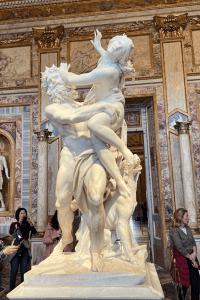 3/ The Galleria Borghese, originally the palace of the Borghese family, filled with enough statuary to rival the earth’s population. Most depicted Christian motifs, some was “borrowed” (permanently) from Greek and Roman temples which, by Christian times, were the equivalent of one-way antique lending libraries for the rich. The artistic virtuosity of the sculptors and artists staggers. To judge from the art, most folks those days romped about scantily clad if at all, a natural adaptation to the Mediterranean climate, no doubt.
3/ The Galleria Borghese, originally the palace of the Borghese family, filled with enough statuary to rival the earth’s population. Most depicted Christian motifs, some was “borrowed” (permanently) from Greek and Roman temples which, by Christian times, were the equivalent of one-way antique lending libraries for the rich. The artistic virtuosity of the sculptors and artists staggers. To judge from the art, most folks those days romped about scantily clad if at all, a natural adaptation to the Mediterranean climate, no doubt.
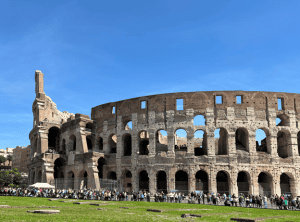 4/ The Colosseum in which gladiators and wild animals would fight, a precursor to American politics.
4/ The Colosseum in which gladiators and wild animals would fight, a precursor to American politics.
5/ Castel Sant Angelo, a columbarium, or a building originally designed to hold urns filled with ashes of dead Roman emperors in niches along its helical interior ramp. Later it was turned into a fort and then into a prison and torture chamber with tools of the trade displayed. It is obvious from the illustrations and tools that man has devoted as much genius to tormenting others as to art, music, and literature. An interesting enough place, perhaps more suitable for an exorcism than a christening. We ate pastry on the battlements.
Posted here is Emperor Hadrian’s death poem, dedicated to his soul:
Little lost and gentle soul,
Companion and guest of the body,
Get ready now to go down into
Colorless, arduous and bare places,
Where you will no longer have the usual
entertainment.
6/ Villa D’Este belonging to Cardinal D’Este. Like all Catholic clergy, he took a vow of poverty but boy could he stretch a dollar. His gargantuan villa in the town of Tivoli channels an entire river to run its water features (ponds, lakes, streams, fountains) to outdo a Disney water park and give generations of maintenance-folk job security. The villa, slathered with fine art, might have had fifty-thousand or so bedrooms, parlors, living rooms, reception rooms, etc., but was woefully short on bathrooms. We’d be fascinated to know what it costs to heat. Wondrous place. Come with a strong bladder.
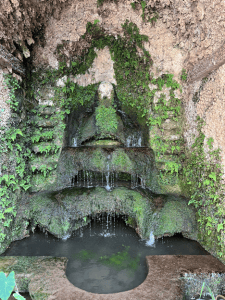
7/ Hadrian’s Villa, the villa of an emperor of Rome, is 300 acres large which means that it’s a long walk to answer the front doorbell. All that’s left are remnants, a pool here, a wall there, an arch or two. With its steam rooms and pools and gardens it was in fact a resort, reminiscent of those in the White Lotus series, undoubtedly seething with skullduggery. Hadrian approached his personal relationships in such a way that we’re pretty sure he was from Brooklyn.
8/ Museo Cripta Cappucini which is not a drink at Starbucks though it should be. It is a church of the Capuchin monks with a crypt below artfully lined with their bones (mercifully placed there only after they died). Arranging them is obviously a subspecialty of interior decoration that deserves a comeback. It makes abundantly clear that our bodies are the temporary chassis for our souls. It creeped us out. (Alas, no pictures were allowed.)
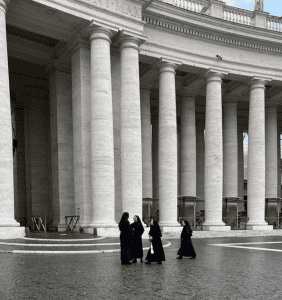 9/ St. Peter’s Basilica which is the Quadruple Cheeseburger with Bacon of churches, plated in so much stone and stuffed with so many statues, it’s a wonder the earth doesn’t tip over. Much like the Pantheon, it is proportioned with a genius that brings human scale and kindles religiosity. There were schools of priests and gaggles of nuns.
9/ St. Peter’s Basilica which is the Quadruple Cheeseburger with Bacon of churches, plated in so much stone and stuffed with so many statues, it’s a wonder the earth doesn’t tip over. Much like the Pantheon, it is proportioned with a genius that brings human scale and kindles religiosity. There were schools of priests and gaggles of nuns.
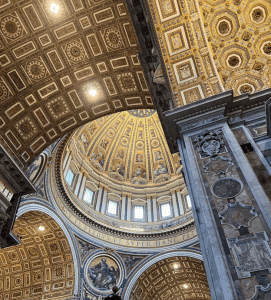 We climbed to the top of the cupola along a helical ramp between its inner and outer shells that progressively narrowed. Towards the end the space was such that we walked severely tilted inward, cricking our spines but worth it for the great view up top.
We climbed to the top of the cupola along a helical ramp between its inner and outer shells that progressively narrowed. Towards the end the space was such that we walked severely tilted inward, cricking our spines but worth it for the great view up top.
In the basement of the basilica many popes are buried in sarcophogi. For those with basements looking to save on burial costs, take heed.
10/ The Sistine Chapel’s ceiling which is an enormous canvas for Michelangelo’s biblical art. It is also the ultimate tourist mosh pit with jacket-and-tie ushers sheep-dogging the tourist crush forward. We probably would have been more impressed if we weren’t trying so hard simply to breathe. No photos allowed.
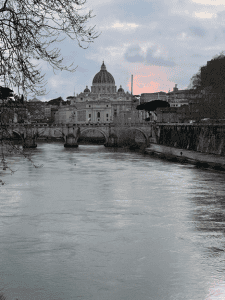
11/ Ostia Antica which was the major port town for ancient Rome, about 15 minutes away by modern tram, a day’s chariot ride. Reconstructing the look of the city requires the same inferential leap as reconstructing crime victims’ faces from their skulls. Archaeologists have done just this and as you walk along you can overlay their drawings on the city’s remaining undercarriage, brick walls and arches and lavish mosaic floors and stone streets with wheel ruts.
Insomuch as most homes didn’t have running water, one of the major elements to this town, and countless like it, was baths where water was heated by wood fire. Slaves who tended the fires had a lifespan of about twenty-five years. A long lifespan for a soft life was sixty-five years. And to think that in several hundred years eternally youthful tourists will comb through our remnants, probably making snarky comments.
12/ The Tiber River which bisects the city.
We ate at:
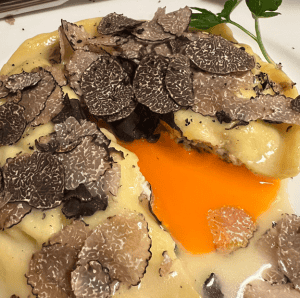 Trattoria Monti, our favorite restaurant of the trip. The hosts were remarkably warm, attentive, hospitable. Standout dishes were a parmesan flan, a single large ravioli strewn with truffle, stuffed with ricotta and a raw egg yolk that spilled out when you cut in,
Trattoria Monti, our favorite restaurant of the trip. The hosts were remarkably warm, attentive, hospitable. Standout dishes were a parmesan flan, a single large ravioli strewn with truffle, stuffed with ricotta and a raw egg yolk that spilled out when you cut in,
duck with candied shallots and prunes, a caramelized pear tart.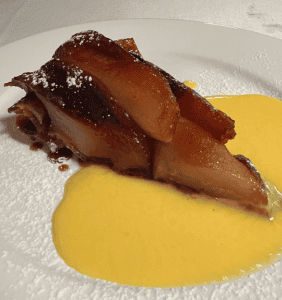
They also served by far the best Prosecco we’ve ever had. This is one of the few restaurants that we’d gladly revisit.
Mercato Testaccio, a food hall with many pocket-restaurants – all pulling hard to serve excellent, unpretentious food – and we swooned. We had a porchetta sandwich on salted focaccia with lots of crunchy skin.
And a baked rice-stuffed tomato. And a poached artichoke. 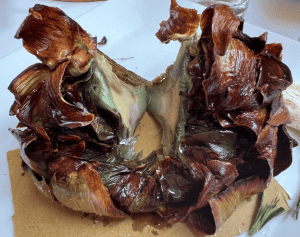
And plastic glasses of excellent red wine. Wow! This was better food than that at most posh restaurants we visited at a fraction the cost. We’d gladly revisit.
Then come the restaurants highly touted by critics and influential bloggers and magazines:
La Ristorante Ciambella, much hailed in the press. Aside from a memorable artichoke tarte tatin, the food was fussy and cute, forgettable. We’d never go back.
Ristorante Aventina which was terrible, serving dry, stringy steak and an inedible pork dish, the server not even inquiring when they removed our dishes that were basically uneaten. We’d never go back.
Ristorante Emma, touted for its pizza which had a crust like wet Kleenex. We’ve had better toaster pizza. We’d never go back.
Nonna Betta which is renowned for its deep-fried artichoke which was a mushy, oily mess. We’d never go back.
Cafe Roscioli which is famed for its pasta which was tasty but nowhere near epiphanous. We were jammed into a small space in the back with only an inch separating us from other tables. Nothing private could be said without being posted on the internet within seconds. Service was worse than poor. It was rude. When we tried to discuss the kind of wine we wanted our server rolled his eyes. He forgot one of the dishes we ordered and then charged us for it (which is a strong reminder to always check your bill). Though their focaccia was outstanding, we’d never go back.
Unsung streetside cafes generally served food as good or better than places sung by critics (which makes us suspicious that these critics are shills) and less expensively. Two we visited had superb deep-fried artichokes. Eating them was like eating salty, crispy artichoke potato chips.
One of them had an inexpensive table wine that we adored. And sitting outside on a winding, cobblestone lane is the height of charm.
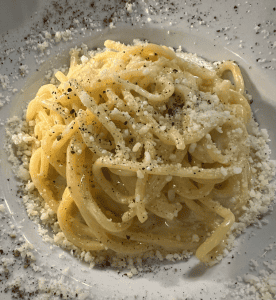 Generally speaking, the restaurants of Rome were about 30% less expensive than corresponding restaurants in the United States but, to honor them with our candor, 30% worse. For instance, almost the only pastas served were carbonara, amatriciana, cacio e pepe (pasta with fresh ground black pepper), and gricia. The pastas were served more to-the-tooth than commonly here, which we liked. But, the late Salmonberry restaurant in teensy Wheeler served far better, more interesting pastas. We think of their life-altering housemade mafaldine (with specks of dulse incorporated in the dough) glazed in a fish fumet decked with sauteed rockfish. Or their pasta in a reduced cream sauce with whole poached garlic cloves, fresh peas, pork belly, and specks of deep-fried quinoa which brought a light staccato crunch. We dream of them still. In Rome these would be weird, even heretical.
Generally speaking, the restaurants of Rome were about 30% less expensive than corresponding restaurants in the United States but, to honor them with our candor, 30% worse. For instance, almost the only pastas served were carbonara, amatriciana, cacio e pepe (pasta with fresh ground black pepper), and gricia. The pastas were served more to-the-tooth than commonly here, which we liked. But, the late Salmonberry restaurant in teensy Wheeler served far better, more interesting pastas. We think of their life-altering housemade mafaldine (with specks of dulse incorporated in the dough) glazed in a fish fumet decked with sauteed rockfish. Or their pasta in a reduced cream sauce with whole poached garlic cloves, fresh peas, pork belly, and specks of deep-fried quinoa which brought a light staccato crunch. We dream of them still. In Rome these would be weird, even heretical.
We stopped at a number of gelato shops seeking the holy grail of gelato which surely, we thought, must exist in Rome. Their gelato was good enough but we thought that the made-from-scratch gelato at Crab Rock Pizza in Garibaldi was better. We suspect that most places got their gelatos from a central production point, possibly with additives, and were not housemade.
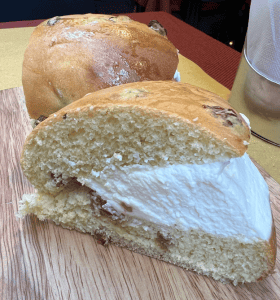 Same deal with pastry except for their Maritozzi, a panettone-like bread in the shape of a small football with whipped cream in the middle which makes us bicycle our legs and bark in our sleep.
Same deal with pastry except for their Maritozzi, a panettone-like bread in the shape of a small football with whipped cream in the middle which makes us bicycle our legs and bark in our sleep.
It’s as though many Roman chefs are dependent on the same dusty cookbooks as their forefathers, rooted in tradition, shunning innovation. How they must despair cooking their ten millionth pasta carbonara, the culinary equivalent of Sisyphus pushing the boulder up the hill only to have it roll down, time after time. That has to affect their cooking overall. Could arm tattoos up their game? Or battling Bobby Flay? Or could this be an issue of market-force? It’s what customers want, so it’s what they provide, and so customers want it, a dysfunctional loop.
We stayed at:
Relais Rione Ponte. It’s in a lovely building, with an elevator (Thomas the Tank Engine’s cousin, hard working and cheerful) visible through wire mesh, right next to the Piazza Navona. Our room was large with a high ceiling, furnished nicely, with an excellent king bed, and an outstanding double-sink bathroom with a very large shower stall. When windows were closed almost all street noise ceased. There was daily housekeeping (which is less and less common in the United States). Sadly, there was no bar or restaurant, and consequently no buzz to gladden the heart. Still, it was reasonably priced compared to other places and we got our buzz off the street. We highly recommend it and would surely stay there again.
Not only does present day Rome throb with life, so does ancient Rome. In Rome you’re thronged by people and by ghosts (and by concupiscent gods). Like all places we’ve visited, we have quibbles (with food usually, because we’re persnickety that way) but we loved the city’s unique self. We hope to return when we can make the nut.
And remember, you are not a Roman god or goddess. So, for goodness sake, keep your pantheon.

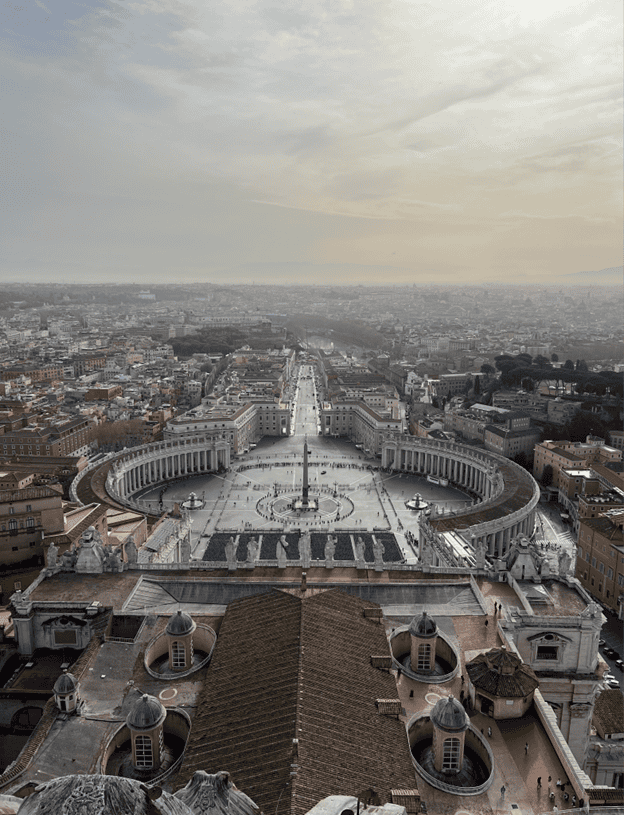
.png)